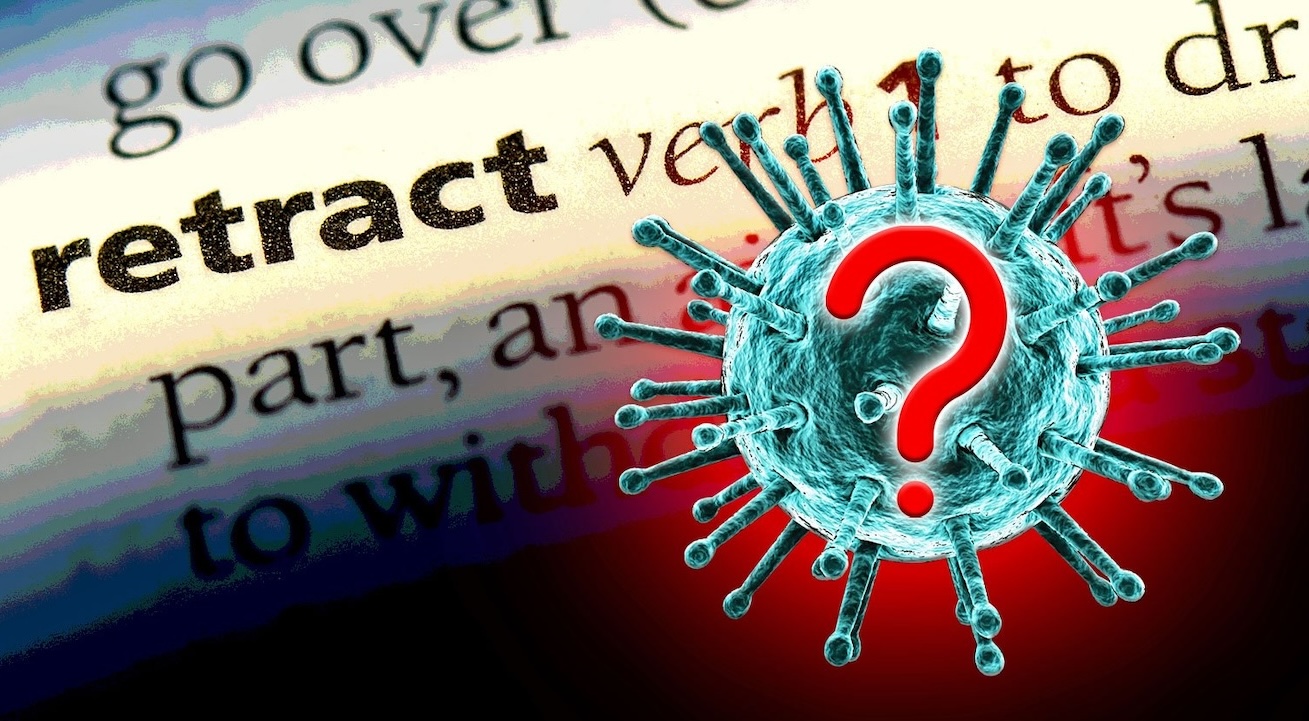21 Scientists Ask Journal to Retract New Paper Claiming COVID Originated in Wuhan Market
by Michael Nevradakis – originally published by The Defender – Children’s Health Defense association website
A paper published Thursday by leading proponents of the “zoonotic” theory of the origin of COVID-19 doubles down on the theory — with the authors claiming to have pinpointed the specific section of the Wuhan, China, market where they say the virus jumped from animals to humans.
Leading virologists and scholars have already criticized the paper, which NPR described as “controversial.”
Twenty-one researchers signed a letter to the editors of Cell (link below), asking them to issue an editorial expression of concern for the paper and launch an investigation that could lead to the paper’s retraction.
The authors themselves, in an interview with NPR, conceded the paper “doesn’t prove by any means that there were infected animals at the market” even if the authors believe it is “the most likely hypothesis.”
Published in the journal Cell, the paper presents the results of what CNN called an “in-depth analysis of the genetic material from hundreds of swabs taken from the walls, floors, machines and drains inside the Huanan Seafood Wholesale Market” in Wuhan, which the paper calls an early epicenter of COVID-19’s spread.
According to NPR, the new study “shows with unprecedented granularity — down to the individual market stall — that coronavirus-susceptible wildlife and the SARS CoV-2 virus were mingling, along with human beings, in a very specific part of the Wuhan market.”
CNN reported that while the study “doesn’t prove that the animals were infected by the virus … their DNA was found very near the virus, sometimes on the same swab. That means it’s a strong possibility the animals were infected at the market.”
Animals “known to be susceptible to Covid-19 infections,” such as raccoon dogs and rabbits, were present at the market, CNN reported. The study claims the virus was present at the market between mid-November and mid-December 2019, “at the same time as the virus from the larger pandemic.”
Michael Worobey, Ph.D., head of the Department of Ecology and Evolutionary Biology at the University of Arizona and a co-author of the paper, told NPR, “We now have … a much richer record of what happened in this case than we do for HIV or the Spanish flu or even the 2009 H1N1 influenza epidemic.”
Kristian Andersen, Ph.D., director of infectious disease genomics at the Scripps Research Institute in La Jolla, California, told CNN the method used in this study is “basically carbon-dating viruses.” Andersen said scientists have never before had information available to them in such detail for any prior pandemic.
Key scientists point to conflicts of interest, ‘serious issues’ with the paper
But other key scientists and researchers took issue with the paper and its conclusions, pointing to other studies and news reports suggesting COVID-19 was a product of controversial gain-of-function research conducted at the Wuhan Institute of Virology and that the virus subsequently leaked from the facility.
In February 2023, a U.S. Department of Energy report concluded COVID-19 emerged as a result of such a lab leak.
Rutgers University molecular biologist Richard Ebright, Ph.D., an outspoken critic of gain-of-function research, told The Defender, “The paper presents no new data and no new analysis and draws unsound conclusions.”
Ebright pointed out that four of the authors — Andersen, Robert Garry, Edward Holmes, and Andrew Rambaut — were accused of fraudulently claiming SARS-CoV-2 couldn’t have originated in a lab in a paper they published in 2020.
That paper — “The proximal origin of SARS-CoV-2,” widely known as “Proximal Origin” — was published in Nature Medicine in March 2020. Researchers, media and the U.S. government widely cited the paper early in the pandemic to support the zoonotic theory of COVID-19’s emergence.
However, a congressional report released in July 2023 found that Dr. Anthony Fauci, then-director of the National Institute of Allergy and Infectious Disease, and Dr. Francis Collins, then-director of the National Institutes of Health (NIH) exerted “extensive influence” on the paper, its “flawed analysis” and its conclusions.
According to the report, the “Proximal Origin” paper was used to “downplay the lab-leak hypothesis” and label as “conspiracy theorists” anyone who suggested the virus may have leaked from a lab.
WUHAN-GATES – 76. The Criminal Partner of Fauci & Gates LIED to US Congress on SARS-Cov-2 BioWeapon
The report suggested Fauci and Collins were involved in the conceptualization, drafting and publication of “Proximal Origin,” and that the scientists involved were pressured to reach the conclusion that COVID-19 had a zoonotic origin.
Other reports have indicated that Fauci was personally aware of risky NIH-funded gain-of-function research at the Wuhan lab, which may have led to the development of the SARS-CoV-2 virus.
‘Clear basis to infer the paper may be a product of scientific misconduct’
Ebright and Stanford University professor of Health Policy Jay Bhattacharya, M.D., Ph.D., were among the 21 researchers who wrote to the editors of Cell.
The letter calls attention to “serious issues” with the paper, arguing it “has unsound premises, has unsound conclusions, and may be a product of scientific misconduct.”
According to the letter’s signatories, “Compelling evidence has been presented that four of the authors [of the paper] committed scientific misconduct, publishing conclusions they knew to be invalid, on a previous paper on the same subject,” referring to the “Proximal Origin” paper.
The letter states:
“Private email and Slack communications of authors Andersen, Garry, Holmes, and Rambaut — made public through a Congressional inquiry — establish that Andersen, Garry, Holmes, and Rambaut knew the premises and conclusions of their paper were invalid at the time the paper was drafted, at the time the paper was submitted for publication, and even at the time the paper was published. …
“When a paper … has unsound premises and conclusions and has authors who committed scientific misconduct on a previous unsound paper on the same subject and may have committed scientific misconduct on subsequent unsound papers on the same subject, there is clear basis to infer the paper may be a product of scientific misconduct.”
Writing on Substack, research scientist and author James Lyons-Weiler, Ph.D., said “The paper suffers from numerous flaws,” including “weak assumptions on zoonotic origins,” “overdrawn conclusions about genetic tracing,” “speculative correlation of animal and viral data,” “logical gaps in interpretation of environmental samples” and “speculation on geographic origin.”
“It is worth noting that the credibility and reputation of many of the authors depend on society accepting their conclusions — yet the paper includes no mention of this major conflict of interest,” Lyons-Weiler wrote.
Jamie Metzl, Ph.D., a senior fellow at the Atlantic Council and a faculty member of NextMed Health and is known as the “original whistleblower” of COVID-19 origins told NPR the new paper’s findings are questionable.
“What they did is to say we’re going to prioritize our sampling in a specific section of the market. It’s circular logic to say, well, we have more positive samples concentrated on the western side of the market when, according to the Chinese sources, that was where they were doing most of their sampling,” Metzl said.
According to NPR, the paper’s “analysis relies on an imperfect set of data gathered by Chinese scientists, which has left this research open to criticism by some researchers — in particular, those who argue a leak from the Wuhan Institute of Virology is a more likely source of the virus’s spread.”
Authors concede paper ‘doesn’t prove’ zoonotic origin of SARS-CoV-2
Some co-authors of the new paper appear to hedge when asked whether their findings definitively conclude that SARS-CoV-2 had a zoonotic origin.
“It doesn’t 100% prove that those animals had SARS-CoV-2, but it shows that you can just say goodbye to the idea that these [coronavirus-susceptible] animals weren’t even there at the time the pandemic started,” Worobey told NPR. The animals “were observed there in November [2019] by Chinese colleagues,” he added.
But Metzl questioned this conclusion. “These same authors are once again trying to promote a false consensus about science that is at very least debated,” Metzl said. “It’s just not the case, as these guys would have you believe, that this is science and the other side are a bunch of crazy people with agendas. This is disputed science.”
NPR cited a 2021 study in Molecular Biology and Evolution placing the start of the outbreak at September or October of 2019, “which would complicate the market-origin hypothesis,” and a 2023 study by Jesse Bloom, Ph.D., an evolutionary biologist at the Fred Hutchinson Cancer Center in Seattle, finding that no particular species of mammal at the Wuhan market correlated with the presence of SARS-CoV-2.
“What the new study does not show is that any given animal at the market was infected with SARS-CoV-2, meaning it cannot rule out that all the viral samples collected came from humans,” NPR reported.
by Michael Nevradakis – originally published by The Defender – Children’s Health Defense association website




